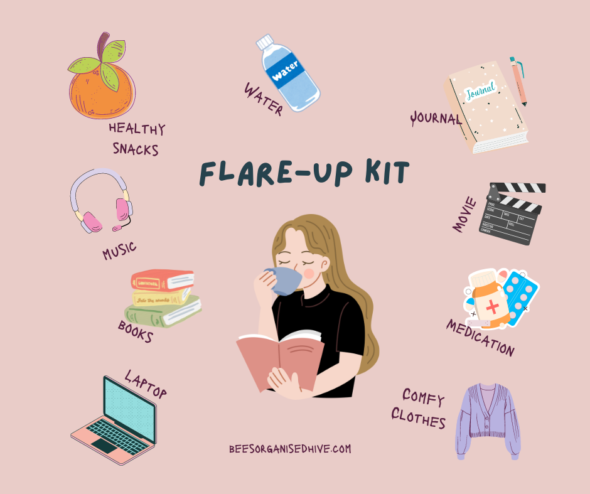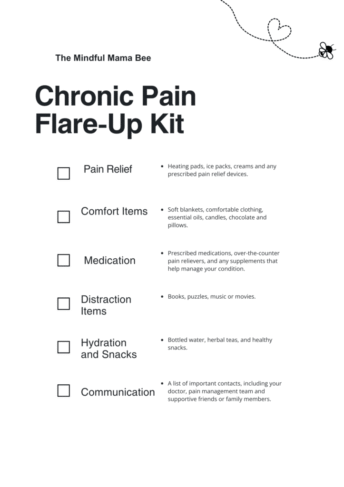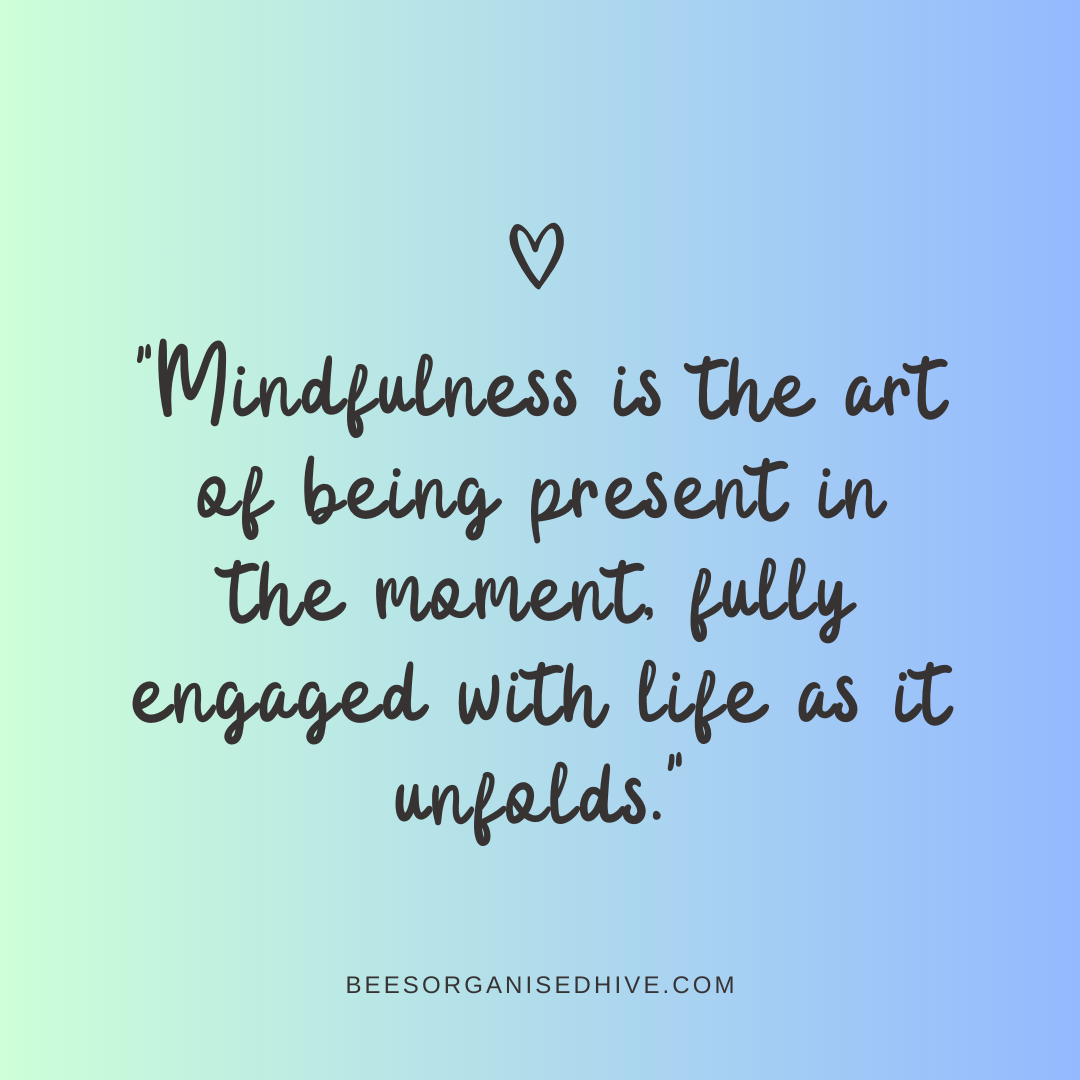In this post

Living with chronic pain is an ongoing challenge for me. I have CRPS and have had it since the age of 10. Read my pain journey here for more.
Flare-ups can transform a manageable condition into an overwhelming and terrifying experience.
Whether you suffer from fibromyalgia, arthritis, or another chronic pain condition. Trying to understand what happens during a flare-up, how to cope, and how to prepare can make a big difference in your quality of life.
Enjoy and don’t forget to comment at the end, I love hearing from you and subscribe to get access to FREE printables, newsletters, the latest posts and more.

What Happens During a Chronic Pain Flare-Up?
I have had my pain for 25 years and I never knew what a “flare-up” meant. I just called it, hell!
So if you are in the same boat then I want to clarify what a flare-up is and how you may experience it.
A chronic pain flare-up is an amount of time when your usual pain increases beyond your normal pain levels.
These episodes can be triggered by different factors. Including stress, weather changes, overdoing it, or even seemingly out of nowhere.
During a flare-up, you might experience:
Increased Pain:
The intensity of pain can spike, affecting different parts of your body. For myself, it feels like I am literally on fire.
Fatigue:
The body’s response to managing high levels of pain often leads to extreme tiredness. I often just sleep in between screaming.
Reduced Mobility:
Higher pain levels can make movement more difficult and sometimes impossible. Sometimes I can’t even walk, get dressed or have people walk in the same room as where I am.
Emotional Distress:
Anxiety, frustration, and even suicidal thoughts can happen.
Coping with a Flare-Up
When a flare-up happens, having a set of things to manage the pain and maintain some quality of life is crucial.
Here are some helpful ways I cope:
Please comment and share your story about how you cope.
1. Rest
Sounds obvious right? But If you are not in tune with your pain then you will miss the warning signs your body is giving you.
Allow your body to rest as much as possible. Overdoing it can add to the flare-up.
2. Heat and Cold
Use heating pads or ice packs to manage pain in specific areas.
I use cooling socks with a gel-cream applied first.
Lots of people like using weighted blankets or fluffy socks. Make a note of what works for you.
Don’t forget to drink plenty of fluids too.
3. Medication
Follow your doctor’s advice about pain relief medications.
Do not hesitate to use prescribed medications during flare-ups.
If you haven’t had a chat with your doctor about your flare-ups, now is the time to discuss it. Before one not during.
4. Mindfulness and Relaxation
You have heard me go on and on about my love for meditation and mindfulness but there is a very good reason for that. Doing things like deep breathing, meditation, and muscle relaxation can help manage pain and reduce stress.
I used to overlook this a lot but it makes a huge difference.
Here is my favourite app to try out. It’s free.
Also, check out my other posts on meditation and add those to your daily routine.
5. Gentle Movement
While rest is important, gentle stretching or short walks can help improve circulation.
The last thing we want is to rest so much that we lose our muscle strength. That being said, take it easy and listen to your body, move when you are able to.
6. Hydration and Nutrition
Drink plenty of water and try to keep a balanced diet. By all means, have your favourite sweet treat, we have to get through this in the best way we can.
I just ask you not to binge on junk, this won’t make you feel any better long term.
Having an unbalanced diet will only hinder your mental health.
Duration of a Flare-Up
The duration of a flare-up can vary widely from person to person and on the condition.
Some flare-ups last a few hours, while others can extend to several days or even weeks.
My last one lasted 3 weeks.
Keeping a pain diary to track triggers and flare-up durations can provide great insights into managing future episodes.
Take a look at my pain journal I created and use daily. You can buy it on Amazon.
Why having a flare-up kit is important
Having a flare-up kit for chronic pain is a must for managing sudden and intense episodes properly.
It took me a long time to realise I needed to put together a flare-up kit and why it was important for me to have one.
Chronic pain conditions, such as fibromyalgia, arthritis, and back pain, often involve unpredictable flare-ups that can severely impact daily life as you know.
A flare-up kit, tailored to each person, helps to give that person access to tools and resources. This can reduce symptoms and reduce the severity of the episode.
Firstly, a flare-up kit means preparedness, reducing the stress and anxiety that comes with sudden pain.
I often feel helpless in times of a flare-up so knowing that I have the necessary items on hand can give me a sense of control.
Lastly, having a flare-up kit empowers us to take proactive steps in managing our condition.
Overall, a well-prepared flare-up kit is a must-have part of our lives in maintaining quality of life for us with chronic pain conditions.

Creating a Flare-Up Kit
A flare-up kit is a personalised collection of items that help you manage pain and discomfort during a flare-up.
Here’s how to create one:
1. Pain Relief
Include items such as heating pads, ice packs, creams and any prescribed pain relief devices.
My go-to’s are my cooling socks, medication and a bath.
2. Comfort Items
Soft blankets, comfortable clothing, essential oils and pillows to support painful areas.
I love candles and chocolate. Hehe.
3. Medication
Make sure you have enough prescribed medications, over-the-counter pain relievers, and any supplements that help manage your condition.
4. Distraction Items
Books, puzzles, music or movies to help take your mind off the pain.
I love a good film, always adding books in, and playing Wii games with my girls if I can.
Distractions are probably the most important part of a flare-up kit for me.
5. Hydration and Snacks
Bottled water, herbal teas, and healthy snacks to keep your body nourished. As I said I always keep some chocolate in my flare-up kit but just don’t binge.
6. Communication
A list of important contacts, including your doctor, pain management team and supportive friends or family members.

The Importance of Support
Having the support of loved ones or those you live with can massively impact your ability to manage a flare-up.
Here’s why support is essential and why I let my family help me.
Emotional Encouragement
I used to deal with my pain on my own as much as I could. What I didn’t realise was that my children and husband felt powerless.
It just hadn’t occurred to me they would feel that way.
We discussed this as a family and that’s when we added my flare-up kit. They all know what to do when I am in pain. This helps them as much as it helps me.
Knowing that others understand and empathise with your situation can reduce feelings of isolation and depression.
Don’t forget you can join online communities if you live alone.
Practical help
My family help with daily tasks such as cooking, cleaning, or running errands.
I love doing things for myself so this can be hard for me to rely on others. But they care and just want to help.
This helps me from overdoing it and helps for a quicker recovery too.
Tips for Building a Supportive Environment
Educate Your Loved Ones
Share information about your condition and what happens during a flare-up. This will help them better understand your needs.
Don’t forget to share your feelings, thought process, and anything else.
Communicate Clearly
Let them know how they can help you during these times. Whether it’s by helping in a physical way or simply being a comforting friend.
Create a Plan
Create a plan together for managing flare-ups. This can include who to call for help, how to handle household tasks, and ways to offer emotional support.
This is just what we did and it changes everything for me when I am in a flare-up.
Bee's Final Thoughts
Chronic pain flare-ups are an inevitable part of living with a chronic pain condition. We can manage our pain levels as best as we can on a daily basis by pacing and using our pain journal.
Our pain is not who we are though!
By understanding what happens during a flare-up, adding useful coping strategies, preparing a flare-up kit, and leaning on the support of loved ones, you can get through these challenging times.
Please comment and share your pain journey with me. Or simply say hi when you need a familiar voice.
I am here and I can support you. I know what it is like to be in constant pain. You are not alone.
Thanks for reading, and don’t forget to get your FREE copy of the checklist.
Bee
The Mindful Mama Bee
Instagram | Pinterest | Facebook









